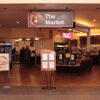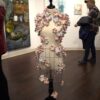Speaker presents suggestions to pre-med students
NIC pre-med students learned ways to succeed in their chosen field at a March 6 presentation sponsored by WWAMI (Washington, Wyoming, Alaska, Montana and Idaho medical school cooperative).
Guest speaker Mary Baringa, assistant dean for regional affairs at the University of Washington School of Medicine, started off by saying, “I want to keep this casual tonight; I don’t want to lecture you.” She added that one of the worst ways to learn is in a lecture hall, citing active or problem-based learning as a better alternative.
“Research experience is a good thing to have under your belt,” Baringa said. “Job shadowing gives you a good idea of what people do and volunteering shows a willingness to put others first.”
Grades are not the whole story, she said, noting that the medical profession takes a look at the whole applicant. If you’ve gone the extra distance, that’s important. Someone who can reflect is just as meaningful as someone with a long list of achievements, she said.
Things the medical profession looks for include a passion for medicine, shadowing experience, college course completion, academic excellence, research experiences, good communication skills, compassion/empathy, work experience, letters of recommendation, extracurricular activities, services/volunteer work, leadership and maturity.
Admission requirements include one year of biology, one year of physics, one year of English, two years of chemistry, physician shadowing research and the Medical College Application Test (MCAT).
Additionally, an MMI (multiple mini-interview) is conducted, which Baringa described as the “speed dating of medicine.” This involves how students react to stress, multitasking, handling situations and problem solving. They also perform medical scenarios that must be acted upon.
Baringa said she grew up on a sheep ranch in Cambridge, Idaho and explored various medical fields before becoming a family physician in Plummer.
“I had no idea what being a doctor meant,” she said. “I’m here to say Grey’s Anatomy is not what it’s about. TV medicine is not reality.”
Idaho funds 20 new WWAMI medical students each year, with students spending their first year in Moscow, their second year in Seattle and third and fourth years at clinical sites throughout Idaho.
Idaho had 20 seats available in 1971, Baringa said, and today there are 20 seats. The figures don’t add up, she said. Legislators are working to increase the number of slots available, thus keeping students in Idaho the entire four years by creating a residency training opportunity in Coeur d’Alene.
“There is a tsunami coming, and we’re not prepared for it,” she said. According to Baringa, Idaho is short on doctors and there is a huge need for health professions. Idaho is one of the oldest physician workforces and ranks 49 in the nation of doctors per capita.
Make yourselves as competitive as possible, she said, for by the year 2016 there will be more qualified students than we have residencies for.
“We must stay current,” she said, warning that the medical profession is always changing. Ninety percent of what we learn today is proven false in five years, she said.
She advised students who are serious about exploring the medical field to get in contact with an advisor, “if it’s the only information you take home tonight.”













